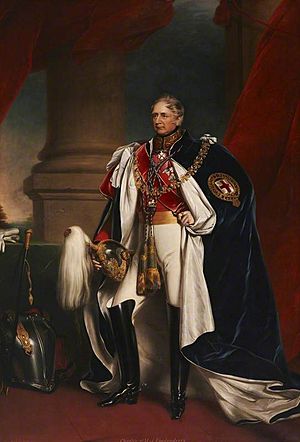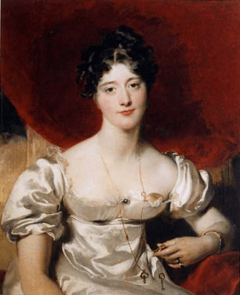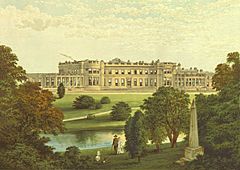Charles Vane, 3rd Marquess of Londonderry facts for kids
Quick facts for kids
The Most Honourable
The Marquess of Londonderry
|
|
|---|---|

Portrait of the Marquess of Londonderry as a Knight of the Garter, c. 1853-54
|
|
| Tenure | 1822–1854 |
| Predecessor | Robert Stewart |
| Successor | Frederick Stewart |
| Born | 18 May 1778 Mary Street, Dublin |
| Died | 6 March 1854 (aged 75) Londonderry House, London |
| Buried | Longnewton, County Durham |
| Spouse(s) |
|
| Issue Detail |
|
| Father | Robert Stewart, 1st Marquess of Londonderry |
| Mother | Lady Frances Pratt |
Charles William Vane, 3rd Marquess of Londonderry (1778–1854) was an important figure in British history. He was an Anglo-Irish nobleman, a brave British soldier, and a clever politician. He fought in major wars like the French Revolutionary Wars and the Napoleonic wars. He was especially good as a cavalry leader during the Peninsular War (1807–1814).
After his military career, Charles became a diplomat. His half-brother, Lord Castlereagh, helped him start this new path. He served as an ambassador in important European cities like Berlin and Vienna.
Charles married twice. His second marriage to Lady Frances Anne Vane brought him great wealth. He even changed his last name to Vane. In 1822, he became the 3rd Marquess of Londonderry. He owned large lands in Ireland and coal mines in England. He was known for being a very strict landlord and mine owner.
Early Life and Family
Charles was born on May 18, 1778, in Dublin, Ireland. His birth name was Charles William Stewart. He was the second son of Robert Stewart. His mother was Frances Pratt, Robert's second wife.
His father's family was from Scotland and had settled in Ulster, Ireland. They were wealthy landowners. Charles's mother was English. Her father was Charles Pratt, 1st Earl Camden, a famous judge. Charles grew up in the Church of Ireland.
Charles had an older half-brother from his father's first marriage:
- Robert (1769–1822), also known as "Castlereagh." Robert became a very famous statesman and played a big role in Charles's life.
Charles also had 11 full brothers and sisters.
Military Career
Charles began his army career very young. In 1791, at just 12 years old, he joined the British Army as an ensign. He quickly moved up the ranks.
He fought in the French Revolutionary Wars in Europe. He also helped put down the Irish Rebellion of 1798. In 1803, he became an aide-de-camp (a personal assistant) to King George III.
Fighting in the Peninsular War
Charles's most important military actions were during the Napoleonic Wars, especially in the Peninsular War in Spain and Portugal.
He led a cavalry group in the Corunna Campaign (1808–1809). He was praised for his role in the cavalry fight at Benavente. Here, a French general was captured. Charles later became Adjutant General (a senior administrative role) to Sir Arthur Wellesley (who later became the Duke of Wellington).
Even though his job was mostly administrative, Charles still saw a lot of action. He showed great bravery at the battle of Talavera (July 1809) and at Fuentes de Oñoro (May 1811). At Fuentes de Oñoro, he even captured a French Colonel by himself!
He left his army position in 1812. Some say it was due to health, others that Wellington dismissed him. Wellington respected him as a soldier but found him difficult to work with. In 1813, he was made a Knight Companion of the Bath, which meant he was now called Sir Charles Stewart.
Diplomatic Career
Charles's half-brother, Robert, was a very successful diplomat. Robert helped Charles start his own diplomatic career.
Ambassador to Austria
From 1814 to 1823, Sir Charles was the British Ambassador to Austria. To make him more accepted in Vienna, he was given the title Baron Stewart in 1814. He also received honorary degrees from Oxford and Cambridge universities.
Lord Stewart attended the famous Congress of Vienna with his half-brother. This was a big meeting where European leaders decided the future of Europe after Napoleon's defeat. Charles was known for his sometimes rough behavior at these meetings.
He also observed other important meetings in Europe, like the congresses of Troppau, Laibach, and Verona.
Marriages and Children
Charles married his first wife, Lady Catherine Bligh, in 1804. They had one son:
- Frederick William Robert Stewart, 4th Marquess of Londonderry (1805–1872).
Catherine died in 1812.
In 1819, Lord Stewart married his second wife, Lady Frances Anne Vane-Tempest. She was very rich and inherited a lot of money. Charles even changed his last name to Vane as part of her father's will.
Charles and Frances had several children:
- George Henry Robert Charles William Vane-Tempest, 5th Marquess of Londonderry (1821–1884).
- Lady Frances Anne Emily Vane (1822–1899). She married John Spencer-Churchill, 7th Duke of Marlborough.
- Lady Alexandrina Octavia Maria Vane (1823–1874).
- Lord Adolphus Frederick Charles William Vane-Tempest (1825–1864). He became a politician but later had health issues.
- Lady Adelaide Emelina Caroline Vane (c. 1830–1882).
- Lord Ernest McDonnell Vane-Tempest (1836–1885).
Through his daughter Lady Frances, Charles was the great-grandfather of Winston Churchill, a famous British Prime Minister.
Estates and Wealth
With his second wife's huge wealth, Lord Londonderry bought the Seaham Hall estate in County Durham, England. He developed the coal mines there and even built a harbor at Seaham.
He also built a grand mansion called Wynyard Park. It cost a lot of money to build and furnish. The family also redecorated their Irish home, Mount Stewart, and bought a large house in London, which they renamed Londonderry House.
Industrialist and Landlord
Charles Londonderry was a powerful industrialist and landlord. He owned many coal mines.
Mines and Child Labor
In 1842, a law called the Mines and Collieries Act was proposed. This law aimed to stop women and young children from working underground in mines. Londonderry strongly opposed this law. He argued that boys as young as eight were needed in the mines, especially in smaller tunnels. He believed that making tunnels taller for adults would cost too much money.
Irish Famine
During the terrible Great Irish Famine that began in 1845, Londonderry was one of the richest men in the United Kingdom. Many landlords tried to help their tenants during this time. However, Londonderry was criticized for not being generous. He and his wife gave very little money to help the local people. At the same time, they spent a lot of money renovating their home in Ireland. He also refused to lower rents for his tenants, which made many people angry.
Later Life and Death
Londonderry became friends with Louis-Napoléon Bonaparte (who later became Napoleon III of France) when Bonaparte was living in London. After Bonaparte became president, Londonderry asked him to free Abd-el-Kader, an Algerian leader.
In 1842, he became the Lord Lieutenant of Durham, an important official position. In 1852, when the Duke of Wellington died, Londonderry was given his place as a Knight of the Garter, a very high honor.
He passed away on March 6, 1854, in London. He was buried in Longnewton, County Durham. His wife had a statue built in Durham to remember him. His eldest son, Frederick, also built Scrabo Tower in Ireland as a monument to his father.
Charles was succeeded as Marquess of Londonderry by his son Frederick from his first marriage. Later, his son George from his second marriage became the 5th Marquess.
Works and Writings
The 3rd Marquess was a writer and editor. He wrote books about his own military and diplomatic experiences. He also published many papers left by his half-brother, Lord Castlereagh.
War Memoirs
He wrote two books about the Napoleonic Wars:
- Narrative of the Peninsular War (1828)
- Narrative of the War in Germany and France: In 1813 and 1814 (1830)
Castlereagh Papers
He also collected and published his half-brother's important papers in several volumes. These books give a lot of information about the history of that time.
Images for kids
-
Memorial statue by Raffaelle Monti in Durham
See also
- Marquess of Londonderry – learn more about his title
- Earl Camden – learn about his mother's father's title





